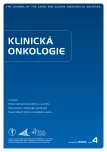Atypical course of typical lung carcinoid
Authors:
L. Jakubíková
Authors‘ workplace:
Klinika nemocí plicních a tuberkulózy, FN Brno
Published in:
Klin Onkol 2020; 33(4): 302-308
Category:
Case Report
doi:
https://doi.org/10.14735/amko2020302
Overview
Carcinoids have been classified according to their embryonic origin in the past and are now categorized and classified as neuroendocrine tumors, including low malignant typical carcinoids, moderate malignant atypical carcinoids, and highly malignant large cell neuroendocrine and small cell carcinomas. A typical carcinoid is a previously used term for the current designation of a grade I neuroendocrine tumor, well differentiated, belonging to a group of rare tumors with a good prognosis with metastasis of less than 15% with a five-year survival of more than 90%, rarely producing serotonin. Even this biologically favorable tumor with a relatively low degree of metastasis cannot be underestimated.
Case: The following section summarizes the classification of neuroendocrine tumors, their diagnosis and treatment, and the second section presents a specific case of a patient with multiple metastases of an original lung carcinoid (histology at the time of surgery 2012, at the time of using this older version of neuroendocrine tumors) describing its further treatment.
Conclusion: In well differentiated neuroendocrine tumors, there is a significant risk of metastasis despite their radical surgery; their dispensarization is therefore necessary.
The authors declare they have no potential conflicts of interest concerning drugs, products, or services used in the study.
The Editorial Board declares that the manuscript met the ICMJE recommendation for biomedical papers.
Keywords:
everolimus – neuroendocrine neoplasm – octreotide
Sources
1. Sedláčková E, Bajčiová V et al. Neuroendokrinní nádory, 1. vydání. Praha: Maxdorf 2016: 180–199.
2. Pelosi G, Sinzogni A, Harari S. Classification of pulmonary neuroendocrine tumors: new insights. [online]. Available from: https: //www.ncbi.nlm.nih.gov/pmc/articles/PMC5653522/.
3. Travis W, Brambilla E, Burke A et al. WHO classification of tumours of the lung, pleura, thymus and heart. 4th Ed. Lyon: IARC Press 2015.
4. Travis WD, Brambilla E, Nicholson AG et al. The 2015 World Health Organization classification of lung tumors: Impact of genetic, clinical and radiologic advances since the 2004 classification. J Thorac Oncol 2015; 10 (9): 1243–1260. doi: 10.1097/JTO.0000000000000630.
5. Caplin ME, Baudin E, Ferolla P et al. Pulmonary neuroendocrine (carcinoid) tumors: European Neuroendocrine Tumor Society expert consensus and recommendations for best practice for typical and atypical pulmonary carcinoids. Ann Oncol 2015; 26 (8): 1604–1620. doi: 10.1093/annonc/mdv041.
6. Hendifar AE, Marchevsky AM, Tuli R. Neuroendocrine tumor sof the lung: Current challenges and advances in the diagnosis and management of well-differential disease. J Thorac Oncol 2017; 12 (3): 425–436. doi: 10.1016/j.jtho.2016.11.2222.
7. Tomíšková M, Jakubíková L, Kadlec B. Neuroendokrinní plicní nádory. [online]. Dostupné z: https: //onkologickarevue.cz/cs/neuroendokrinni-plicni-nadory.
8. Tomíšková M, Venclíček O, Skřičková J. Karcinoid plic. In: Základy moderní pneumoonkologie. 2. rozš. vyd. Praha: Maxdorf 2017: 393–403.
9. Sedláčková E, Bajčiová V et al. Neuroendokrinní nádory. 1. vyd. Praha: Maxdorf 2016: 156–163.
10. Papamichail DG, Exadaktylou PE, Chatzipavlidou VD. Neuroendocrine tumors: Peptide receptors radionuclide therapy (PRRT). Hell J Nucl Med 2016; 19 (7): 75–82.
11. HoražďovskýP, Hytych V, Hromádka P. Chirurgická léčba neuroendokrinních nádorů plic. In: Neuroendokrinní nádory plic a mediastina. Praha: Maxdorf 2014: 93–115.
12. Venclíček O, Tomíšková M, Skřičková J. Karcinoid plic. In: Základy moderní pneumoonkologie. Praha: Maxdorf 2012: 336–345a.
13. Kadlec B, Skřičková J. Léčba malobuněčného karcinomu plic. In: Základy moderní pneumoonkologie. Praha: Maxdorf 2012: 203–211.
14. Fazio N, Buzzoni R, Dekke Fave G et al. Everolimus for the treatment of advanced, non-functional neuroendocrine tumours of the lung or gastrointestinal tract (RADIANT-4) lung subgroups analysis. Cancer Sci 2018; 109 (1): 174–181. doi: 10.1111/cas.13427.
15. den Bakker MA, Thunnissen FB. Neuroendocrine tumours-challenges in the diagnosis and classification of pulmonary neuroendocrine tumours. J Clin Pathol 2013; 66 (10): 862–869. doi: 10.1136/jclinpath-2012-201310.
16. Travis WD. Advances in neuroendocrine lung tumors. Ann Oncol 2010; 21 (Suppl 7): vii65– vii71. doi: 10.1093/annonc/mdq380.
17. Kunz PL. Carcinoid and neuroendocrine tumors: building on success. J Clin Oncol 2015; 33 (16): 1855–1863. doi: 10.1200/JCO.2014.60.2532.
Labels
Paediatric clinical oncology Surgery Clinical oncologyArticle was published in
Clinical Oncology

2020 Issue 4
- Metamizole vs. Tramadol in Postoperative Analgesia
- Metamizole at a Glance and in Practice – Effective Non-Opioid Analgesic for All Ages
- Possibilities of Using Metamizole in the Treatment of Acute Primary Headaches
- Current Insights into the Antispasmodic and Analgesic Effects of Metamizole on the Gastrointestinal Tract
- Spasmolytic Effect of Metamizole
Most read in this issue
- Cervical cancer in pregnancy
- Integrated diagnostics of diffuse gliomas
- Atypical course of typical lung carcinoid
- Gamma-heavy chain disease
